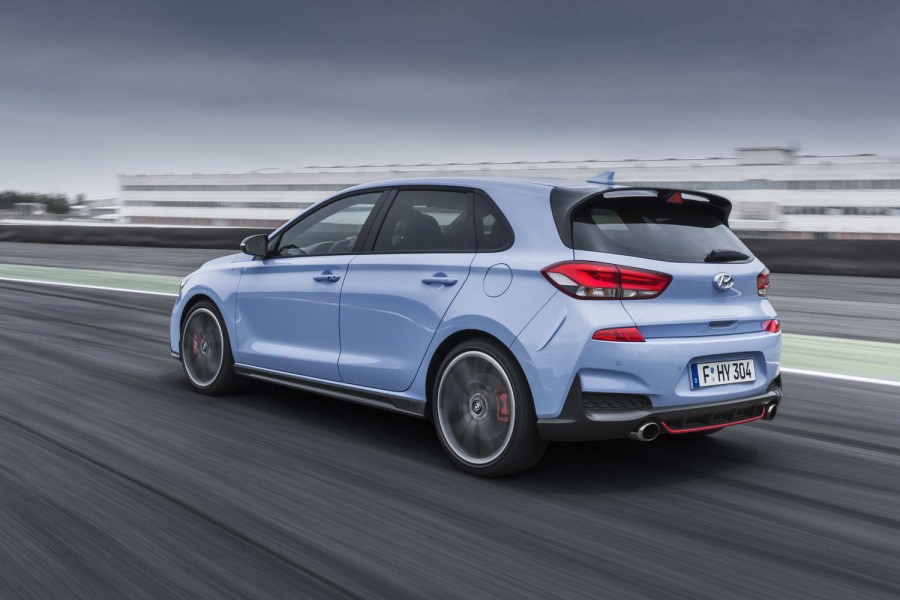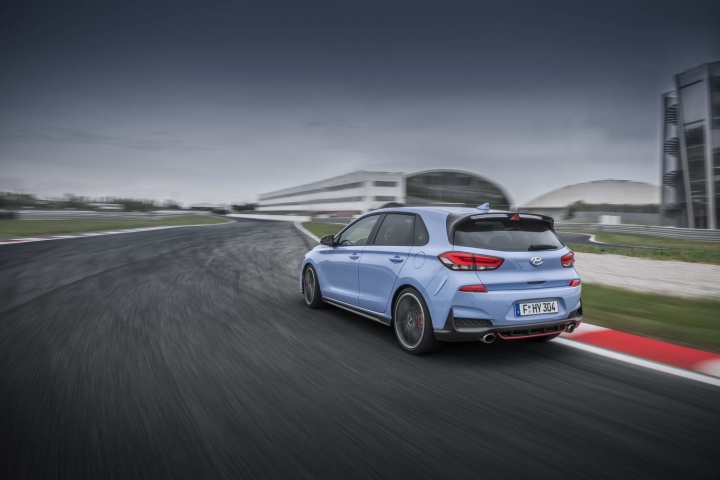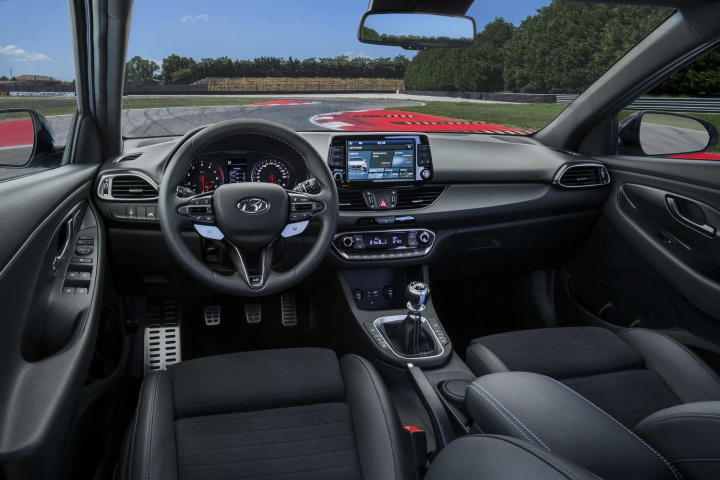What's the news?
Here it is - this is the full run-down and first proper look at Hyundai's brand-new Volkswagen Golf GTI challenger. It's called the i30 N and it comes in two power outputs: 250hp, or 275hp. Here's what you need to know.
Exterior
Discreetly enhanced, the Hyundai i30 N wears all the typical visual addenda of a well-judged hot hatchback. It has meatier bumpers fore and aft, the front item bearing much larger air intakes than you'd find on a regular five-door i30. The headlights have a black-bezel motif and there's a subtle 'N' logo on the 'Cascading Grille', while round the sides are gloss-black skirts along the sills, gloss-black door mirrors and larger alloys - 18-inch items as standard, with N-branded 19s an option, or standard fit on the more powerful version of the i30 N (more details below). Stick with the former and the car is 4mm lower than the regular hatch; the latter sees the drop increase to 7mm.
Round the back, there's a glossy black spoiler housing a triangular third brake light, while you can't miss the diffuser between the widely spaced twin-exit exhausts. There's red pin striping everywhere, while Hyundai says all the design features aim to enhance the aerodynamic capabilities of the car. There's a six-strong colour palette for the i30 N, including two exclusive shades: Clean Slate being one, Performance Blue the other - this latter finish harking back to Hyundai's involvement in the World Rally Championship. The remaining four hues are all borrowed from the regular line-up and include the two flat paints (Engine Red and Polar White), as well as a pair of metallic/pearlescent colours (Micron Grey and Phantom Black).
Interior
More hot hatch goodness inside, as the N steering wheel features drive mode controls, a button for the car's most intense 'N-mode', another switch to control the rev-matching function of the engine and lots and lots of blue detailing - you'll find it used for the stitching, as well as stripes on the gear gaiter and in the instrument cluster. Talking of which, the display in front of the driver has a shift indicator, so you can time your upshifts to perfection, and an LED rev counter that has a variable redline, according to the driving performance and the oil temperature of the engine. That's something seen on BMW's M cars for some time now; no surprise, given the man behind N (Albert Biermann) formerly worked for M. Sport seats with extendable seat cushions can be finished in cloth, or suede and leather, and you will find plenty of 'N' logos scattered about the cabin to lift the ambience.
Mechanicals
We perhaps should have touched on this earlier, but the 'N' stands for a few things, according to Hyundai (and no, you cynics, it's not just 'one letter on' from M... well, it is, but we digress). Anyway, N equates to Namyang, the Korean development centre where the hot i30 was dreamt up; the Nürburgring, pivotal in the development of the car; and the letter N is meant to visually represent a chicane, to further reinforce the sporty driving message.
Powering the i30 N is a 2.0-litre, turbocharged four-cylinder petrol engine that has 250hp in the Standard Package (SP) and 275hp with the Performance Package (PP); that's rather like Peugeot's 308 GTi and the first MkIII SEAT Leon Cupras, which both had two outputs, and it also compares well with the most powerful Golf GTI (currently 245hp) and the Ford Focus ST (250hp). Both Ns deliver their peak power at 6,000rpm and they both have maximum torque of 353Nm. However, the SP model produces that from 1,450- to 4,000rpm, while the PP hangs onto peak torque for an additional 500rpm.
The extra horsepower, slightly wider torque plateau and a shorter final drive (3.25:1, versus 3.176:1 for the SP) means the PP is two tenths of a second quicker from 0-100km/h, clocking in at 6.2 seconds. Both cars are limited to 250km/h flat out. Power is delivered to the front wheels only via a six-speed manual transmission on either variant of the i30 N.
Hyundai says it has worked hard to ensure the chassis can match the grunt of the drivetrain. The big wheels wear Pirelli P-Zero tyres, there are larger brakes all round (gripped by red, N-branded callipers), the car is fitted with an Electronic Limited Slip Differential (E-LSD) and there's a variable exhaust valve system too. The Korean firm claims the steering has been tweaked to be more responsive and faithful at all speeds, while there's a Launch Control function, the aforementioned rev-matching facility (switchable via the steering wheel) and Electronic Controlled Suspension (ECS), which means adjustable damping. There's also an Electronic Sound Generator (ESG) in the cabin to boost the engine's vocals. Five driving modes, selectable and configurable, complete the i30 N's impressive dynamic package.
Anything else?
Hyundai wants the i30 N to be fun to drive and is basing its efforts on three 'cornerstones': Cornering; Race Track Capability; and Everyday Sports Car. If the fast i30 can deliver on these, it should be a belter.
Albert Biermann, Hyundai's executive vice president for Testing and High Performance Vehicle Development, said: "The Hyundai i30 N has been developed for no other purpose than to deliver maximum driving fun to our customers in an accessible high-performance package. With the high-performance N models, we will enhance our brand's appeal with emotional products that cater to the needs of people who love to have a smile on their face when they drive their car on a winding road and listen to the sound of the engine. That's why we measure high-performance in BPM, heart beats per minute, instead of only RPM."
And finally, we've already driven a prototype version of the Hyundai i30 N, so you can read our review of it here.
<iframe src="https://www.youtube.com/embed/_m5ABE2pHn4?rel=0&controls=0&showinfo=0" width="560" height="315"></iframe>


